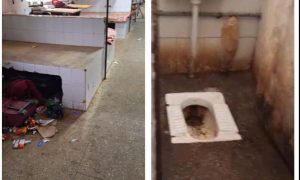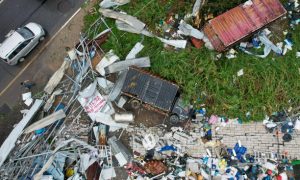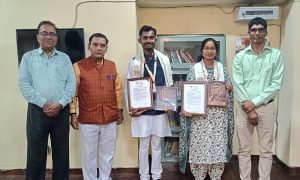The draft report on New Education Policy has come out with a ‘novel’ idea of doing away with universities exclusively for professional courses. The committee does not see any advantage in this arrangement. Why do not we allow these bodies of higher education to offer both academic and professional courses?
‘The practice of setting up stand-alone universities for professional education will be discontinued. All institutions offering either professional or general education must organically evolve into institutions offering both seamlessly by 2030,’ (P16.5.2)
This idea seems to be a good, logical move since there is actually no apparent division separating the two streams of higher education. Whether academic or professional, it is all about providing quality education through able administration that would ensure useful, relevant syllabus and able, efficient faculty. This should be the foremost duty of a higher education body and so whether it is for academic or professional education does not matter so much. The committee, it seems, has got it right.
There is another area of higher education where the committee has done an adequately good job. It is about various courses on Agriculture.
‘There is high demand in the government and development sector for agriculture graduates and there is also increasing demand in the private sector in all aspects of agriculture, particularly high-value agro-industry, food processing and specialised knowledge-intensive areas such as water efficiency, food safety and trade.’
The draft report paints a very rosy picture for agriculture graduates and there is no reason to repudiate the claims of the committee. The challenges before our farmers very much stare at them. Monsoon failures leaving an acute water scarcity, fragmented lands that suit only the ‘not-so-modern’ farming techniques, unfriendly market forces blocking a fair price for the yields and unbearable financial commitments drive the small farmers to the brink of their life. Yet, the study of agriculture holds great promise and this should be great news really.
‘Undergraduate education in agriculture is presently unable to cope with demands from industry, and particularly from agri-business, for trained graduates. The demand is well over twice the present capacity of Agriculture Universities.’(16.6 ‘Agriculture and allied disciplines’) But, the following observation speaks of sheer ignorance and indifference of our youth.
‘Despite the demand, youth are not attracted to this discipline. It is imperative to present the opportunities exist in agriculture to both students and parents, to help them make informed source.’ (P302) This clearly demonstrates that we need to do so much in the field of counselling and advice to the youth and their parents in selection of courses in higher studies. The ‘educationists’ out there on media have their own agenda and work more as propaganda agents than as real counsellors of higher education. (these gentlemen hardly ever bat for government institutions) So, the government, particularly the higher education department, should get into a vigorous campaign to take the ‘message’ to our youth.
The report has a few suggestions as well.
‘All new AUs will be integrated, covering all interrelated aspects including agriculture, horticulture, veterinary sciences, agro-forestry, aquaculture and all the food production systems. They will be encouraged to actively interact with national and international agencies and universities through multimode exchange.’
‘An appropriate framework to continuously upgrade and update agriculture education curriculum and syllabi considering aspects of food safety, quality assurance and disciplines of social sciences like economics, agri-business management, marketing and rural sociology and agricultural ethics and policies will be developed.’
The report deals with Legal education, Healthcare Education and Technical Education as well. But it does not offer much in terms of innovative measures facilitating a qualitative change in the present scheme of things.
Chapter 17 on ‘Empowered governance and effective leadership for higher education institutions’ says that ‘Institutional governance will be based on full autonomy – academic, administrative and financial – for all higher education institutions with financial certainty and backing.’
Similarly, Chapter 18 on ‘Transforming the regulatory system’ reiterates that ‘the National Higher Education Regulatory Authority will be the only regulator for all higher education including professional education.’ We have discussed about it already.
There are as many ‘welfare’ plans as one may expect because there is so much of politicisation of education in our country. Any subsidy, any relief, any help, or any assistance to the weaker sections and other deserving segments must be appreciated without doubt. But for sure, it need not be a part of the ‘New Policy’.
Having said this, we can not deny that welfare schemes connected to education would do great deal of good to our society and our nation as a whole.
The promises on fee waivers would be directly beneficial to the most deserving students. It is one of the portions that are well written.
‘Admissions will be done on a ‘need blind’ basis and the HEI will make best efforts to arrange funding for all those offered admission, and in need of financial support.’
‘The HEI shall ensure that 50% of students in each of its programmes will be given fee waivers ranging from 25% to 100% to socio- economically disadvantaged students. At least 20% students in each programme / course shall have 100% fee waivers. At least 30% students in each programme / course shall get between 100% to 25% fee waivers, ensuring that the fees are affordable for students’.
‘The fair and ethical implementation of the fee regime will be an integral part of the Financial Probity dimension of regulation, including for accreditation.’
After these fee waiver recommendations, the report lists out ‘Principles of good governance’. There are 10 such principles.
‘The Board plays a key role in approving the vision, purpose and strategies of the institution and is accountable to the public; the Board should have an appropriate system of anticipating potential issues and challenges; the Board is responsible for the appointment of CE and the continuing evaluation of his / her performance based on transparent criteria’ are some of the principles enumerated in the draft report. As we have said many times, there is nothing new or worth mentioning about it.
The report then moves on to Part – III –Additional Key Focus Areas. What are these key areas?
‘Technology in Education’ appears first. The objective reads thus: ‘Appropriate integration of into all levels of education – to support teacher preparation and development; improve teaching, learning and evaluation processes; enhance educational access to disadvantaged groups; and streamline educational planning, administration and management.’
The draft hopes that ‘technology will play a critical role in the improvement of educational processes and outcomes. Thus, the relationship between technology and education at all levels is bidirectional’.
The report says that it is ‘worth highlighting’ certain issues in this regard. (P339) What are those ‘highlighted’ problems?
(to continue…
Baskaran Krishnamurthy
mail: [email protected]




























 WhatsApp us
WhatsApp us
Pingback: Royal praised 롤 강의 in Maine to 롤 승률 last time.
Pingback: 안전바카라
Pingback: concrete floor coating
Pingback: replica tag heuer monaco 69 price
Pingback: http://95.111.232.181/
Pingback: blazing trader review
Pingback: bitcoin era
Pingback: 먹튀검증방법
Pingback: Digital Transformation journey
Pingback: wig with bangs
Pingback: fake watches
Pingback: CI CD
Pingback: sextant instructions pdf
Pingback: rolex sky dweller replica watches
Pingback: Service Virtualization
Pingback: forex trading
Pingback: pic5678
Pingback: visit best carding forum cvv dumps
Pingback: สล็อตวอเลท
Pingback: Buy American Eagle Rifle 7.62x51mm NATO
Pingback: voir
Pingback: สินเชื่อที่ดิน
Pingback: คาสิโนออนไลน์
Pingback: how to create passive income
Pingback: Lincoln Georgis
Pingback: aller à
Pingback: have a peek at this website
Pingback: molly drug images,
Pingback: Buy DMT Powder Online Perth
Pingback: National Chi Nan University
Pingback: تصنيف جامعة المستقبل
Pingback: Sedation dentistry
Pingback: Job Interview Preparation
Pingback: Entrance exams for future university
Pingback: where to buy mushrooms in colorado
Pingback: MBA in Future university in egypt
Pingback: https://www.kooky.domains/post/the-legal-landscape-of-web3-domain-name-ownership
Pingback: Finance program
Pingback: Career opportunities
Pingback: Department of Pharmacognosy and Medicinal Plants
Pingback: Future University
Pingback: top university in egypt
Pingback: Maillot de football
Pingback: Maillot de football
Pingback: seated dips
Pingback: fiverrearn.com
Pingback: french bulldog
Pingback: Private universities in Egypt
Pingback: blockchain
Pingback: clima birmingham
Pingback: texas french bulldogs for sale
Pingback: daftar multisbo
Pingback: puppy french bulldogs for sale
Pingback: future university
Pingback: Piano storage
Pingback: Piano restoration and repair
Pingback: Piano restoration experts
Pingback: Secure piano storage
Pingback: House moving
Pingback: Packing expertise
Pingback: Future University business programs
Pingback: Classic Books 500
Pingback: Training Philippines
Pingback: Sex Australia
Pingback: pupuk anorganik cair
Pingback: Pupuk Organik terpercaya dan terbaik di pupukanorganik.com
Pingback: partners
Pingback: exipure where to buy
Pingback: prostadine reviews
Pingback: puralean reviews
Pingback: Economics
Pingback: ما هي أقسام كلية الصيدلة
Pingback: live sex cams
Pingback: live sex cams
Pingback: live sex cams
Pingback: french bulldog dogs for sale
Pingback: Private University Yemen
Pingback: Scientific Research
Pingback: Generator Repair near me Leeds
Pingback: cheap sex cams
Pingback: frt trigger
Pingback: 늑대닷컴
Pingback: Hold and win slot
Pingback: web designer Singapore
Pingback: 918kiss
Pingback: หวย24
Pingback: Beauty of Joseon glow serum
Pingback: pg slot
Pingback: aplikasi slot online gampang jackpot
Pingback: hotel in windham ny
Pingback: 300 win mag ammo
Pingback: système d exploitation
Pingback: catégorie de logiciels malveillants
Pingback: cybersecurité salaire
Pingback: Nangs delivery 24/7
Pingback: nang tanks
Pingback: itsmasum.com
Pingback: losangeles jobs
Pingback: madrid jobs